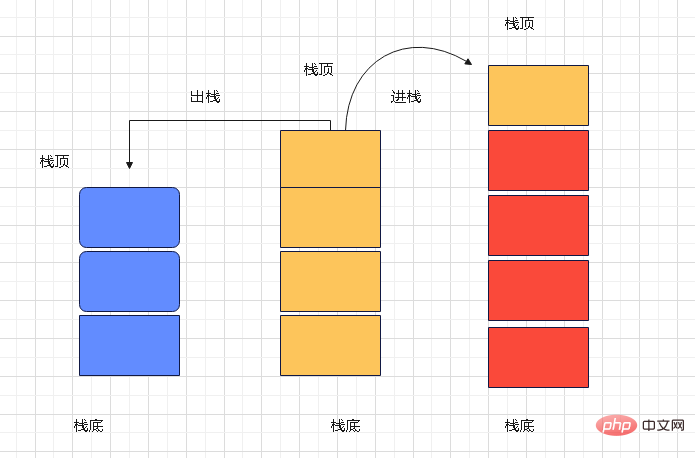Briefly understand the JavaScript data structure and algorithm stack
This article brings you relevant knowledge about javascript, which mainly introduces related issues about the stack, including writing stacks with process-oriented method source code and writing with object-oriented method source code Let’s take a look at the content below. I hope it will be helpful to everyone.

[Related recommendations: javascript video tutorial, web front-end】
1. Get to know Stack
Stack: (stack) also known as stack, it is a linear table with limited operations. Follow last-in-first-out (LIFO)
Top of stack: Limit insertion and deletion operations only to the end of the table Linear table,
Stack bottom: A linear table that limits insertion and deletion operations only to the header.
Push : Inserting a new element into a stack is also called pushing, pushing or pushing. It puts the new element on the top element of the stack. above, making it the new top element of the stack;
Pop : Deleting elements from a stack is also called popping or popping off the stack. The element is deleted and its adjacent elements become the new top element of the stack

2. Write stack oriented to process method source code
2.1 Thinking
2.2 Methods that need to be implementedWhat is process-oriented:
Process-oriented is to analyze the steps to solve the problem, Then use a function to implement it.
Just step by step
execute the call and that’s it.
Before implementing it, let’s think about how we can implement it
- push (element) adds one or more Element to the top of the stack
- pop()Delete the element at the top of the stack and return the removed element
- peek ()Returns the element at the top of the stack
- isEmpty() is used to determine whether the stack is empty. If it is empty, it is empty
- clear()Used to clear the elements of the stack
- size()Used to return the elements in the stack The number of
First we use the array method to implement it, so we need to create a
Empty array to simulate the stack
2.3 source code implementation, and call the classto construct a class, use an array to simulate,
Write each in the class A method
partially calls the method of the array.
In general, it is to use classes to wrap
array methods to implement stack simulation
Running results:class Stack { constructor() { this.item = [] } push(element) { this.item.push(element) } pop() { return this.item.pop() } peek() { return this.item[this.item.length - 1] } isEmpty() { return this.item.length === 0 } clear() { this.item = [] size() { return this.item.length } } //实例化Stack类 const stack = new Stack() stack.push(4) stack.push(6) console.log( stack.pop()) console.log(stack.peek()) console.log(stack.isEmpty()) console.log(stack.size())Copy after login

3.1 Thinking
Object-oriented: is to decompose the things that build the problem into several objects
, The object is not created to complete a certain step , but todescribe the
behavior of something in the process of solving a problem
3.2需要实现的方法
- push(element)添加一个或多个元素到栈顶
- pop()删除钱顶的元素,并返回移除的元素
- peek()返回栈顶的元素
- isEmpty()用于判断栈是否为空,空则为空
- clear()用于清空栈的元素
- size()用于返回栈中元素的个数
- toString()用于将栈以字符串的形式打印
那么在实现这个类,我们用对象来模拟栈
3.3源码及使用类
class Stack {
constructor() {
this.count=0
this.items = {}
}
push(element) {
this.items[this.count]=element
this.count++
}
pop() {
if(this.isEmpty()){
return undefined
}
this.count--
const result=this.items[this.count]
delete this.items[this.count]
return result
}
peek() {
if(this.isEmpty()){
return undefined
}
return this.items[this.count-1]
}
isEmpty() {
return this.count===0
}
clear() {
this.items={}
this.count=0
}
size() {
return this.count
}
toString(){
if(this.isEmpty()){
return undefined
}
let objectString=`${this.items[0]}`
for(let i=1;i<this.count;i++){
objectString=`${objectString},${this.items[i]}`
}
return objectString
}
}
const stack = new Stack()
stack.push(23)
stack.push(34)
stack.push(80)
console.log( stack.pop())
console.log(stack.peek())
console.log(stack.isEmpty())
console.log(stack.size())
console.log(stack.toString())在使用对象来模拟栈时,采用了键:值的方式
来存储数据,比如this.items[this.count]=element
在这个结构中用this.count来记录栈的大小,
当我们向里面插入一个数字时,就分配count为键
插入的值为值。这个时候就需要将this.count++.
关于pop()与peek(),toString()方法都需要
先判断栈是否为空,如果为空则返回undefined。
【相关推荐:javascript视频教程、web前端】
The above is the detailed content of Briefly understand the JavaScript data structure and algorithm stack. For more information, please follow other related articles on the PHP Chinese website!

Hot AI Tools

Undresser.AI Undress
AI-powered app for creating realistic nude photos

AI Clothes Remover
Online AI tool for removing clothes from photos.

Undress AI Tool
Undress images for free

Clothoff.io
AI clothes remover

Video Face Swap
Swap faces in any video effortlessly with our completely free AI face swap tool!

Hot Article

Hot Tools

Notepad++7.3.1
Easy-to-use and free code editor

SublimeText3 Chinese version
Chinese version, very easy to use

Zend Studio 13.0.1
Powerful PHP integrated development environment

Dreamweaver CS6
Visual web development tools

SublimeText3 Mac version
God-level code editing software (SublimeText3)

Hot Topics
 1386
1386
 52
52
 How to implement an online speech recognition system using WebSocket and JavaScript
Dec 17, 2023 pm 02:54 PM
How to implement an online speech recognition system using WebSocket and JavaScript
Dec 17, 2023 pm 02:54 PM
How to use WebSocket and JavaScript to implement an online speech recognition system Introduction: With the continuous development of technology, speech recognition technology has become an important part of the field of artificial intelligence. The online speech recognition system based on WebSocket and JavaScript has the characteristics of low latency, real-time and cross-platform, and has become a widely used solution. This article will introduce how to use WebSocket and JavaScript to implement an online speech recognition system.
 WebSocket and JavaScript: key technologies for implementing real-time monitoring systems
Dec 17, 2023 pm 05:30 PM
WebSocket and JavaScript: key technologies for implementing real-time monitoring systems
Dec 17, 2023 pm 05:30 PM
WebSocket and JavaScript: Key technologies for realizing real-time monitoring systems Introduction: With the rapid development of Internet technology, real-time monitoring systems have been widely used in various fields. One of the key technologies to achieve real-time monitoring is the combination of WebSocket and JavaScript. This article will introduce the application of WebSocket and JavaScript in real-time monitoring systems, give code examples, and explain their implementation principles in detail. 1. WebSocket technology
 How to use JavaScript and WebSocket to implement a real-time online ordering system
Dec 17, 2023 pm 12:09 PM
How to use JavaScript and WebSocket to implement a real-time online ordering system
Dec 17, 2023 pm 12:09 PM
Introduction to how to use JavaScript and WebSocket to implement a real-time online ordering system: With the popularity of the Internet and the advancement of technology, more and more restaurants have begun to provide online ordering services. In order to implement a real-time online ordering system, we can use JavaScript and WebSocket technology. WebSocket is a full-duplex communication protocol based on the TCP protocol, which can realize real-time two-way communication between the client and the server. In the real-time online ordering system, when the user selects dishes and places an order
 How to implement an online reservation system using WebSocket and JavaScript
Dec 17, 2023 am 09:39 AM
How to implement an online reservation system using WebSocket and JavaScript
Dec 17, 2023 am 09:39 AM
How to use WebSocket and JavaScript to implement an online reservation system. In today's digital era, more and more businesses and services need to provide online reservation functions. It is crucial to implement an efficient and real-time online reservation system. This article will introduce how to use WebSocket and JavaScript to implement an online reservation system, and provide specific code examples. 1. What is WebSocket? WebSocket is a full-duplex method on a single TCP connection.
 JavaScript and WebSocket: Building an efficient real-time weather forecasting system
Dec 17, 2023 pm 05:13 PM
JavaScript and WebSocket: Building an efficient real-time weather forecasting system
Dec 17, 2023 pm 05:13 PM
JavaScript and WebSocket: Building an efficient real-time weather forecast system Introduction: Today, the accuracy of weather forecasts is of great significance to daily life and decision-making. As technology develops, we can provide more accurate and reliable weather forecasts by obtaining weather data in real time. In this article, we will learn how to use JavaScript and WebSocket technology to build an efficient real-time weather forecast system. This article will demonstrate the implementation process through specific code examples. We
 Simple JavaScript Tutorial: How to Get HTTP Status Code
Jan 05, 2024 pm 06:08 PM
Simple JavaScript Tutorial: How to Get HTTP Status Code
Jan 05, 2024 pm 06:08 PM
JavaScript tutorial: How to get HTTP status code, specific code examples are required. Preface: In web development, data interaction with the server is often involved. When communicating with the server, we often need to obtain the returned HTTP status code to determine whether the operation is successful, and perform corresponding processing based on different status codes. This article will teach you how to use JavaScript to obtain HTTP status codes and provide some practical code examples. Using XMLHttpRequest
 How to use insertBefore in javascript
Nov 24, 2023 am 11:56 AM
How to use insertBefore in javascript
Nov 24, 2023 am 11:56 AM
Usage: In JavaScript, the insertBefore() method is used to insert a new node in the DOM tree. This method requires two parameters: the new node to be inserted and the reference node (that is, the node where the new node will be inserted).
 JavaScript and WebSocket: Building an efficient real-time image processing system
Dec 17, 2023 am 08:41 AM
JavaScript and WebSocket: Building an efficient real-time image processing system
Dec 17, 2023 am 08:41 AM
JavaScript is a programming language widely used in web development, while WebSocket is a network protocol used for real-time communication. Combining the powerful functions of the two, we can create an efficient real-time image processing system. This article will introduce how to implement this system using JavaScript and WebSocket, and provide specific code examples. First, we need to clarify the requirements and goals of the real-time image processing system. Suppose we have a camera device that can collect real-time image data




